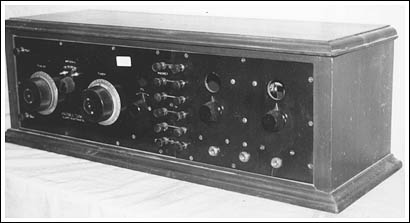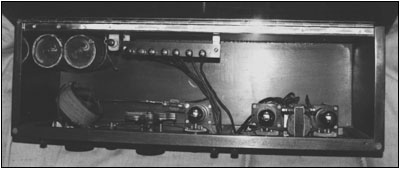Of Old Radios And Related Items--Published Monthly
The Haynes-Griffin DX Receiver
BY WALLY WORTH
Web Edition
While the name Haynes-Griffin is probably familiar to collectors of early battery sets, other readers may not know this company. For the benefit of all, Wally Worth writes about the company and its Model DX receiver. (Editor) The Haynes-Griffin Radio Service Co., Inc., was in business in the early days of radio, about 1922 or 1923. The company made kit sets, including the DX receiver and, later, superheterodyne receivers. Artemis J. Haynes had been in the vanguard of radio since 1917 when he was in the Naval Reserve and attended the Brooklyn Navy Yard Radio School. He became an instructor of the first principles of radio at Yale University. In addition, he worked for the De Forest Radio Co. as an engineer, and during 1920-1921, he operated the De Forest experimental station at Highbridge (2XG), along with Robert F. Gowan at 2XX. Haynes-Griffin Radio Service Co. In 1922, Haynes opened the Haynes Radio Shop, a small store on Lexington Ave. in New York City. Shortly after, a Mr. Griffin joined the firm to assume the position of President, as his expertise was in advertising and merchandising, whereas Haynes was the technical expert. The company then purchased the Lexington Radio and Electric Co., along with the stock and entire personnel. This merger made the Haynes-Griffin Radio Service Co. the oldest and best in New York City, with 4,000 square feet of space devoted to the sale and repair of radio apparatus. The firm, located on 41 West 43rd St., advertised itself as "New York's Largest Radio Store." The DX Receiver A.J. Haynes was the developer of the single tube receiver he called the DX. He claimed that his circuit, using the same two components (variocoupler and variable condenser) as in others, was more sensitive and gave sharper tuning. I found an original list of 41 stations received in 1926 in the cabinet of my set, a fact which certainly lends credence to his statement. In 1923, Popular Radio magazine ran two articles, written by Lawrence Cockaday on the set "How to Build the Haynes DX Receiver" and "How to Build the Haynes 2-Tube Amplifier." Parts lists and cost of parts were included. Each article gave $15 as the cost of parts, along with extensive panel layouts and wiring instructions. The set shown in Figure 1 is from my own collection. Bought about 15 years ago at a local flea market, it came quite complete with three WD12 tubes, knobs, station cards, etc. This set has a nicely engraved separate panel on the 1-tube receiver section, showing "Haynes Tuner" and below that, "Clapp-Eastham Co." as the manufacturer. Figure 2 (see print version) shows this set from your editor's collection.

Figure 1. The Haynes-Griffin DX receiver.
Note that the front panel of my set is divided into two parts one for the receiver and an entirely separate panel for the 2-tube amplifier. The amplifier panel is not engraved and is connected to the receiver panel by the usual multiple binding post assemblies and tie bars. The solid walnut cabinet apparently is a factory product, as evidenced by the excellent workmanship and the use of a long brass piano hinge on the cabinet lid. Figure 3 shows the layout of the internal parts revealing the Haynes variocoupler, the Haynes variable condenser, and the two Haynes audio frequency transformers, all as originally specified in the parts lists.

Figure 3. A view of the internal workings of the Haynes-Griffin Dx receiver showing the layout of the components.
I believe the receiver portion is from the Haynes factory because of the engraved names and knob markings. However, the amplifier portion, having no engraving, could have been added later and then put into the cabinet. All done in a nice fashion, I might add. Later articles in Popular Radio, written by L.C. Cockaday probably around 1926, gave instructions for building Haynes superheterodyne receivers. Concerning the use of the Clapp-Eastham name on the receiver panel, I wonder if this indicates the origin of the Haynes parts in the set. Probably so, as the two audio transformers certainly look like Clapp-Eastham type units. I believe that this set is quite rare, as Haynes certainly didn't make very many of them in the short time he was active. Are there any more of these Haynes-Griffin combination receivers out there? I would welcome any response to compare parts or the layout of other sets. References: Caddell, Alfred M. "A Little Foresight and a Big Success," Radio Broadcast, September 1923. (Courtesy of Alan Douglas.) Pruett, Col. Encyclopedia of Antique Radio, p 73. Popular Radio, September 1923. (Wally Worth, 2 W. Elm Ave., Wollaston, MA 02170.) At age 15, Wally Worth began saving his paper money to buy parts to build 1-tube sets. Fifty years later, he started to collect anything that needed cabinet work. His diverse collecting tastes include crystal sets, 1920s battery radios, early AC sets, transistor and multiband sets, novelty radios, tubes, and both horn and cone speakers.
| [Free Sample] [Books, etc., For Sale] [Subscribe to A.R.C./Renew] [Classified Ads] [Auction Prices] [Event Calendar] [Links] [Home] [Issue Archives] [Book Reviews] [Subscription Information] [A.R.C. FAQ] URL = http://www.antiqueradio.com/Aug01_HayesGriffin.html Copyright © 1996-2001 by John V. Terrey - For personal use only. Last revised: July 30, 2001. For Customer Assistance please contact ARC@antiqueradio.com or call (978) 371-0512 Pages designed/maintained by Wayward Fluffy Publications
Antique Radio Classified |